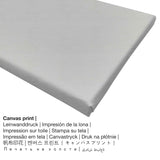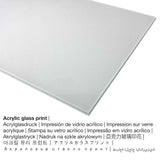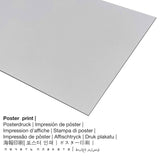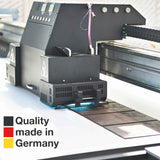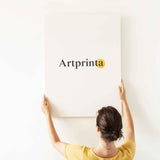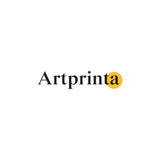Willem Maris, 1880 - ọbọgwụ ọcha nwere ọkụkọ - mbipụta nka mara mma
Ụtụ gụnyere. Mbupu gbakọrọ na ndenye ọpụpụ.
Họrọ nhọrọ ihe ebipụta nka
Maka mbipụta nka ọ bụla anyị na-enye ihe dị iche iche & nha. Ka ị kwekọọ n'ihe ị chọrọ nke ọma, ị nwere ike họrọ n'ime nhọrọ nhazi ngwaahịa ndị a:
- Mbipụta kanvas: The canvas print, not to be confused with an artwork painted on a canvas, is a digital image printed on an industrial printing machine. Furthermore, a canvas makes a cosy and pleasing feeling. A printed canvas of your favorite work of art will let you turn your into a large collection piece. Hanging a canvas print: The advantage of canvas prints is that they are relatively low in weight. That means, it is quite simple to hang the Canvas print without the help of additional wall-mounts. A canvas print is suitable for any kind of wall.
- Mbipụta akwụkwọ mmado (ihe kwaaji): A poster print is a printed sheet of canvas paper with a slightly rough surface texture. Please bear in mind, that depending on the size of the poster print we add a white margin of around 2 - 6cm round about the work of art to facilitate the framing with your custom frame.
- Ugogbe acrylic ebipụtara: A glossy acrylic glass print, often referenced as a plexiglass print, will convert your favorite artwork into wall décor. The artwork will be custom-made thanks to modern UV direct printing technology. This has the effect of deep and rich colors. The great upside of an acrylic glass fine art copy is that sharp contrasts and also image details become more exposed due to the fine gradation in the picture. The acrylic glass protects your chosen fine art print against light and external influences for many decades.
- Mbipụta nke aluminom: Aluminium Dibond prints are metal prints with a true effect of depth. Its non-reflective surface creates a fashionable look. The white and bright parts of the artpiece shimmer with a silk gloss, however without glow. The colors are bright and vivid, fine details appear very clear, and there’s a matte look you can literally feel. The print on aluminium is one of the most popular entry-level products and is an extremely stylish way to showcase art reproductions, as it puts all of the viewer’s focus on the image.
Nkwupụta iwu: We try whatever we can to describe the products as accurate as possible and to illustrate them visually on the various product detail pages. However, the pigments of the printing material, as well as the print result might differ marginally from the image on your screen. Depending on your screen settings and the condition of the surface, color pigments can unfortunately not be printed 100% realistically. Considering that the art prints are processed and printed manually, there may as well be slight differences in the motif's exact position and the size.
Ozi izugbe sitere na webụsaịtị ihe ngosi nka (© Copyright - by Rijksmuseum - Rijksmuseum)
A white duck with seven chicks in a ditch.
Nchịkọta edemede
Ndị na-ese ihe osise ahụ Dutch artist Willem Maris n’afọ 1880. N'oge a, a na-etinye ihe nka na nka Rijksmuseum's nchịkọta nka dijitalụ na Amsterdam, Netherlands. The nkà nke oge a artwork, nke bụ akụkụ nke ngalaba ọha a na-enye ya site n'ikike nke Rijksmuseum.: . Ọzọkwa, nhazi ahụ bụ odida obodo ma nwee oke onyonyo nke 16: 9, which implies that the length is 78% longer than the width. The painter Willem Maris was a European artist, whose artistic style can mainly be attributed to Impressionism. The European artist lived for 66 afọ - a mụrụ n'afọ 1844 na Hague, The, South Holland, Netherlands wee nwụọ na 1910.
Data ndabere gbasara nka nka pụrụ iche
| Akụkụ nka: | "White duck with chickens" |
| Nhazi nka: | sere |
| Otu izugbe: | nkà nke oge a |
| Nhazi oge: | 19th narị afọ |
| Afọ okike: | 1880 |
| Ogologo afọ nka nka: | karịa afọ 140 |
| Ụlọ ihe ngosi nka / mkpokọta: | Rijksmuseum |
| Ebe ebe ngosi nka: | Amsterdam, Netherlands |
| E Nwere na: | Rijksmuseum |
| Licensedị ikike: | ngalaba ọha |
| Site n'aka: | Rijksmuseum |
Banyere akụkọ
| Nkewa edemede: | ọrụ mgbidi |
| Mmeputakwa: | dijitalụ mmeputakwa |
| Produzọ mmepụta: | mbipụta dijitalụ |
| Production: | emepụtara na Germany |
| Ụdị ngwaahịa: | mmepụta ihe na-achọ |
| Ojiji ngwaahịa: | mgbidi gallery, ihe ndozi ụlọ |
| Ndepụta: | nhazi odida obodo |
| Oke akụkụ onyonyo: | 16: 9 |
| Mmetụta akụkụ: | ogologo bụ 78% ogologo karịa obosara |
| Nhọrọ dị: | ígwè obibi akwụkwọ (aluminium dibond), ebipụta canvas, mbipụta akwụkwọ mmado (akwụkwọ kwaaji), mbipụta iko acrylic (nwere ezigbo mkpuchi iko) |
| Canvas dị n'elu ihe nrịbama (mbipụta kanvas) nha dị iche iche: | 90x50cm - 35x20" |
| Mbipụta iko acrylic (nwere ezigbo mkpuchi iko) dị iche iche: | 90x50cm - 35x20" |
| Nhọrọ nha nke akwụkwọ mmado (akwụkwọ kwaaji): | 90x50cm - 35x20" |
| Mbipụta aluminom (aluminium dibond ihe) dị iche iche: | 90x50cm - 35x20" |
| Nhazi mbipụta nka: | na-enweghị etiti |
Tebụl nchịkọta ihe nkiri
| Aha onye nka: | Willem Maris |
| Aha nka ndị ọzọ: | Marris Wenzel, Maris Willem, maris william, william maris, Maris W., w.m maris, Maris Wenzel, Maris W., Maris, Willem Maris, wilhelm maris, Marris Willem, Maris William, W. Maris |
| Gender: | nwoke |
| Obodo onye nka: | Dutch |
| Ọrụ nke onye na-ese ihe: | onye na-ese ihe |
| Country: | mba netherland |
| nhazi ọkwa: | omenkà nke oge a |
| Ụdị nke onye na-ese ihe: | Mmetụta |
| Nwụrụ anwụ: | 66 afọ |
| Afọ ọmụmụ: | 1844 |
| Obodo amụrụ: | Hague, The, South Holland, Netherlands |
| Afọ nwụrụ: | 1910 |
| Obodo ọnwụ: | Hague, The, South Holland, Netherlands |
© Nchekwa ikike nwebisiinka - Artprinta.com


